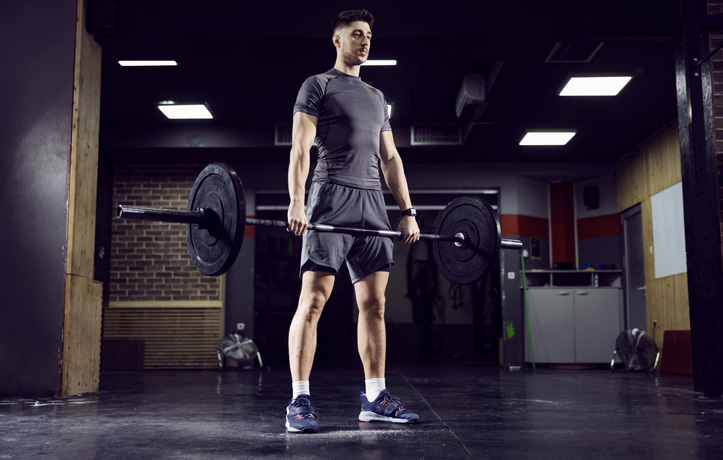By: Scott Lucett, MS, NASM-CPT, PES, CES
We’ve all seen the research about the negative impact sitting for extended periods of time has on our health. But most of us have to sit, at least for a portion of our day. Read on to learn ways to address the postural challenges of our sitting problem with corrective exercise strategies.
Physical inactivity is one of the primary causes of muscular dysfunction, and research suggests that muscular aches and pains are more common now than 40 years ago (1). Labor saving devices and technology such as cars and computers have replaced the need for physical exertion.
This lack of movement causes the body to become deconditioned and more susceptible to injury. This article will review three of the most common postural problems associated with long term sitting and some basic strategies to improve them.
Lumbo-Pelvic-Hip Postural Distortion Pattern
A Lumbo-Pelvic-Hip Postural Distortion Pattern is associated with an anterior pelvic tilt with concomitant excessive lumbar extension (i.e. an excessive arch in the low back region) and is commonly associated with low back pain. This distortion pattern is commonly seen in individuals who sit for extended periods of time as this causes the hip flexor complex (psoas, iliopsoas and rectus femoris) to remain in a shortened position.
Over time, these muscles adapt by shortening and becoming tight. Due to their attachment to the pelvis and lumbar spine, when these muscles are tight, they can pull the pelvis and lumbar spine forward causing an anterior tilt as one stands up (hip extension).
The tightness of the hip flexor complex can also lead to decreased neural drive to their functional antagonist – the gluteus maximus. Tightness in the hip flexors and weakness in the gluteals can ultimately lead to low back pain. To help remedy this situation, a quick corrective exercise strategy would be to first foam roll and statically stretch the hip flexor complex (Figure 1A and B). When foam rolling, hold tender spots for 30 seconds. When statically stretching, hold the stretch for a minimum of 30 seconds and perform 1 to 2 sets. Next, strengthen the gluteus maximus. An example exercise to try is a floor bridge (Figure 2). Perform 1-2 sets of 10-15 repetitions.
Rounded Shoulder Posture
A second common postural condition that comes from sitting for long periods of time is rounded shoulders. This is primarily due to the fact that we are always resisting gravity, and more often than not, gravity wins. Individuals typically do not possess the muscular endurance of the upper back and shoulder muscles to maintain proper postural alignment against gravity when sitting which ultimately leads to rounding the shoulders forward.
When the shoulders are in a rounded position, the anterior muscles acting on the shoulders (pectoralis major and minor) become tight while the posterior shoulder muscles (rotator cuff, rhomboids, mid/lower trapezius) become lengthened and weak. This can lead to shoulder impingement and shoulder pain. A quick solution to help improve alignment is to first foam roll the thoracic spine to help improve thoracic extension range of motion (Figure 3).
Next, statically stretch the pectoralis major and minor (Figure 4), holding the stretch for 30 seconds. Finally, strengthen the posterior shoulder muscles by performing a floor cobra (Figure 5). When performing a floor cobra, make sure to retract the shoulder blades and hold this position for 2-3 seconds before returning to the starting position. Perform 1-2 sets, 10-15 repetitions.
It is also important for people to be aware of their shoulder posture while sitting and to periodically “readjust” their alignment to a more ideal posture. The more one practices proper shoulder alignment, the more muscular endurance they will develop and thus will be able to resist gravity more effectively.
Forward Head Posture
The third common postural distortion seen in people who sit for long periods of time is a forward head posture. Typically, this posture goes hand-in-hand with the rounded shoulder posture and occurs for many of the same reasons (poor muscular endurance of the cervical stabilizers to resist gravity). Individuals with this posture can develop tightness in the upper trapezius and levator scapulae muscles and weakness in the deep cervical stabilizers. Over time, this posture can lead to neck pain and even headaches.
Like the two previous distortions, stretching and strengthening exercises can help improve this condition. First, release the upper trapezius and levator scapulae holding tender spots for 30 seconds. This can be done by using a hand-held device such as a TheraCane (Figure 6). Next, statically stretch the upper trapezius and scalene (Figure 7 and 8). Hold each stretch for 30 seconds and perform 1-2 sets. Finally, perform 1-2 sets, 10-15 repetitions of chin tucks to strengthen the deep cervical flexors (Figure 9).
Like the rounded shoulder posture, it will also be important for people to be aware of their cervical postures while sitting and periodically “readjust” their cervical alignment to a more ideal position. This will help develop muscular endurance in their cervical stabilizers.
Summary
In today’s work environment and daily life, it’s difficult (if not impossible) to get away from the use of computers. Using computers while sitting for extended periods of time can wreak havoc on one’s posture. With some basic corrective exercise strategies, the risk of injury that can come from postural problems elicited by long term sitting can be reduced.
By improving work stations in such a way that allows one to stand while working can also help combat these issues. Many corporate environments are incorporating adjustable desks which allow people the ability to elevate their computer monitors and keyboards to assist with better postural alignment. Making adjustments to the workspace along with basic corrective exercise strategies may be the best combination to help create a better structural environment to resist gravity, improve posture, and decrease the risk of injury.
- Harkness EF, Macfarlane GJ, Silman AJ, McBeth J. Is musculoskeletal pain more common now than 40 years ago? Two population-based cross-sectional studies.Rheumatology (Oxford) 2005;44(7):890–5.
















